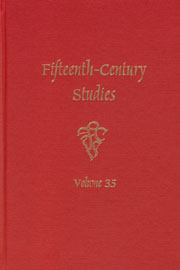Book contents
- Frontmatter
- Contents
- Preface
- Essays
- 1 Violencia en tres cuentos hagiográficos de la España medieval
- Physical Impairment in the First Surgical Handbooks Printed in Germany
- Serious Elements in Medieval French Farces: A New Dimension
- Narrative Afterlife and the Treatment of Time in Henryson's Testament of Cresseid
- Euclid in Boethius's De Consolatione Philosophiae and Some of its English Translations
- Seeking the Medieval in Shakespeare: The Order of the Garter and the Topos of Derisive Chivalry
- A Revelation of Purgatory and Chaucer's Prioress
- Eyeglasses for the Blind: Redundant Therapies in Meschinot and Villon
- Jean de Meun in the Cité des Dames: Author versus Authority
- The Festival Context of Villon's Pet au Deable: Martinmas in Late-Medieval Paris
Physical Impairment in the First Surgical Handbooks Printed in Germany
from Essays
Published online by Cambridge University Press: 12 September 2012
- Frontmatter
- Contents
- Preface
- Essays
- 1 Violencia en tres cuentos hagiográficos de la España medieval
- Physical Impairment in the First Surgical Handbooks Printed in Germany
- Serious Elements in Medieval French Farces: A New Dimension
- Narrative Afterlife and the Treatment of Time in Henryson's Testament of Cresseid
- Euclid in Boethius's De Consolatione Philosophiae and Some of its English Translations
- Seeking the Medieval in Shakespeare: The Order of the Garter and the Topos of Derisive Chivalry
- A Revelation of Purgatory and Chaucer's Prioress
- Eyeglasses for the Blind: Redundant Therapies in Meschinot and Villon
- Jean de Meun in the Cité des Dames: Author versus Authority
- The Festival Context of Villon's Pet au Deable: Martinmas in Late-Medieval Paris
Summary
Chiara Benati
From a modern point of view, surgery represents a natural form of intervention against different forms of physical impairment and can alleviate infirmities if not heal them completely. Thus, early during the diagnostic phase of an affliction, one may consider whether an operation can be performed to alleviate the debilitating condition.
Yet the assumption that surgery represents the solution to pathologies resulting in lameness or blindness, for example, does not automatically seem valid for earlier stages in the history of medicine and surgery; for instance, during the late Middle Ages. The study of how various forms of physical impairment were treated as demonstrated in popular surgical handbooks of this era can help us ascertain what the relationship was between impairment and surgery as perceived by contemporaries, thus widening our view. Early sources in Germany include Hieronymus Brunschwig's Buch der Cirurgia and Hans von Gersdorff's Feldtbuch der Wundarzney, both of which will be discussed in this study.
Hieronymus Brunschwig's “Buch der Cirurgia”
The Buch der Cirurgia, Hantwirckung der wundartzny von Hyeronimo brunschwig, the first surgical handbook printed in German, was first published in folio on July 4, 1497, by the Strasbourg printer Johannes Grüninger. The first edition was soon followed by others:
December 1497, Augsburg, Hans Schönsperger, folio;
Das buch der wund // Artzeny. Handwirckung der Cirurgia…, “uff den Palmabent,” 1513, Strasbourg, Johannes Grüninger, folio;
1534, Augsburg, Alexander Weyssenhorn, quarto; and, once again,
1539, Augsburg, Alexander Weyssenhorn, quarto.
- Type
- Chapter
- Information
- Fifteenth-Century Studies , pp. 12 - 22Publisher: Boydell & BrewerPrint publication year: 2009

